|
Week 7: September 12-18, 2014 |
Welcome
to the McGill Bird Observatory weekly report.
Click here for a complete listing of our archives.
Comments or
questions are welcome at "mbo AT migrationresearch.org".
|
PICTURE
OF THE WEEK: |
|
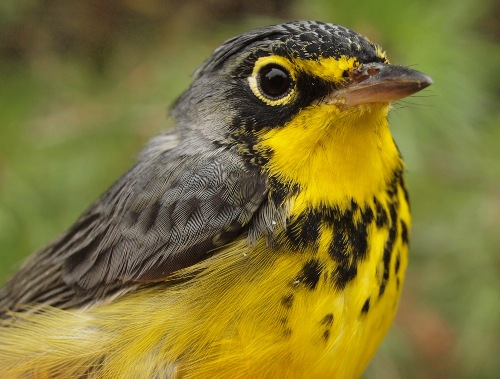
Canada Warblers are primarily an August migrant at MBO in fall, but we still got the one
above this week, our 23rd of the season, a better total than over the past three years.
(Photo by Simon Duval)
-
|
|
|
THIS WEEK |
THIS FALL |
2014 TOTAL |
SITE TOTAL |
|
# birds (and species) banded |
324 (41) |
1593 (65) |
3092 (83) |
49402 (115) |
|
# birds (and species) repeat |
99 (20) |
414 (40) |
753 (53) |
9887 (70) |
|
# birds (and species) return |
6 (4) |
41 (17) |
181 (31) |
1615 (38) |
|
# species observed |
90 |
124 |
152 |
209 |
|
# net hours |
560.0 |
3595.0 |
7008.4 |
86191.7 |
|
# birds banded / 100 net hours |
57.9 |
44.3 |
44.1 |
57.3 |
|
|
Note: table does not include nocturnal banding (owls) |
|
Banders-in-charge: Simon Duval and Gay Gruner
Assistants: Angelika Aleksieva,
Sue Bishop, Cindy Bouchard, Iain Caldwell, Luke Currin, David Davey, Jean Demers, Leah den Besten, Marianna Dimauro, Nathalie Gendron, Pedro Grillo, Nicole Guido, Alison Hackney, Lisa Keelty, Helen Kohler, Marcel Lebeau, Catherine Legault, Valentin Lucet, Betsy McFarlane, Ana Morales, Benoît Piquette, Catherine Russell, Ahmad Shah, Clémence Soulard, Elise Titman, Rodger Titman, Christiane Tremblay, Jay VanderGaast, Yifu Wang
Notes:
Migration picked up noticeably this week, with 324 birds of 41 species banded, both slightly above average for this middle week of the Fall Migration Monitoring Program. However, for a second straight week we had a record number of repeats for the period, suggesting that unusually many migrants are stopping over at MBO for at least a second day. The 90 species observed this week was just barely below the record count of 91 at this time last year.
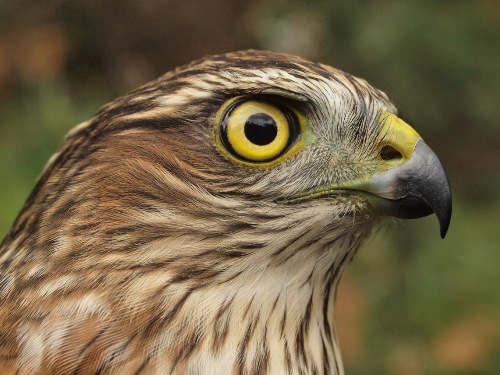
Until recently it was an unusually quiet fall for Sharp-shinned Hawks at MBO, but with one last week and another five this week, numbers are now close to average for the season.
(Photo by Simon Duval)
|
Again this week we did not add any new species for the year in terms of observations, but banded two species for the first time in 2014 – Blue-headed Vireo and Gray-cheeked Thrush. In addition, we banded our first Winter Wren and Yellow-rumped Warbler of the fall. The Blue-headed Vireo and Gray-cheeked Thrush were also the first observed this fall, and that was the case as well for Orange-crowned Warbler (our 24th warbler species of the season) and Rusty Blackbird.
This week’s top 10 [last week's rank in brackets]
# individuals banded |
mean # individuals observed daily |
1. Magnolia Warbler (94) [2] |
1. European Starling (175) [-] |
2. Nashville Warbler (26) [-] |
2. Canada Goose (137) [6] |
3. Red-eyed Vireo (23) [3] |
3. Common Grackle (108) [-] |
4. Tennessee Warbler (14) [4] |
4. American Crow (75) [3] |
5. Gray Catbird (13) [5] |
5. Ring-billed Gull (63) [-] |
5. American Redstart (13) [5] |
6. Broad-winged Hawk (50) [-] |
5. White-throated Sparrow (13) [7] |
7. Red-winged Blackbird (31) [-] |
8. Wilson's Warbler (12) [-] |
8. Blue Jay (29) [7] |
9. American Goldfinch (11) [1] |
9. American Robin (25) [2] |
10. Common Yellowthroat (10) [10]
|
10. American Goldfinch (23) [1] |
|
This was a big week for Magnolia Warbler, with more than three times as many of them banded as any other species. While Magnolia Warbler has been the top species banded in week 7 four times previously (2008, 2010, 2011, 2013), the 94 individuals banded was a new high, eclipsing the 84 from this time last year, and more than double the next closest total of 46 in 2008. Nashville Warbler moved up into second place, with the highest count for week 7 since 2005 when we had a strong movement of 38 individuals banded. The strong migration of Red-eyed Vireos continues unabated, in third place for a third week in a row, and with the season total now up to 111 individuals, just short of the record of 117 set in our first full fall in 2005. Like Nashville Warbler, it was the highest count of Red-eyed Vireos in week 7 since 2005. Meanwhile, Gray Catbird is a step ahead, and has already set a new season record as of this week – how high will the new total go?
The top species observed this week reflect a substantial change over previous weeks. European Starling has not been in the top ten at all this season, yet shot right to the top this week with a mean daily count of 175 individuals. It has not been common at this time of year in most past years either, appearing in the top ten for week 7 in just one-third of previous fall seasons, and with a top mean daily count of 75 in 2013. Starlings weren’t the only birds this week shooting up in abundance – Canada Goose increased nearly tenfold over last week, and Common Grackle also rocketed back into prominence with over 100 per day on average. American Crow dropped one spot in the rankings despite doubling in numbers, while Ring-billed Gull and Broad-winged Hawk also were new additions to the top ten, with mean daily counts of 50 or more individuals – impressive in that until this week, no species had reached that count over the course of a week, and this week six species did. Rounding out the list of the five new additions to the list this week, Red-winged Blackbird came in seventh place, and is sure to increase further as the season progresses. Blue Jay numbers also doubled from last week. American Robin numbers are similar to where they have been for most of the season, but got pushed down the list this week by virtue of all the new species arriving in large numbers.
|
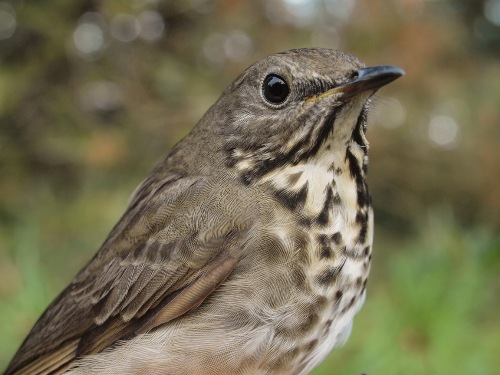
The first Gray-cheeked Thrush of the fall.
(Photo by Simon Duval)
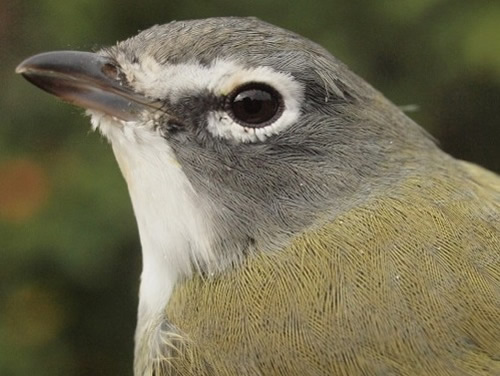
Blue-headed Vireos are the latest of the vireos to come through MBO, and are on the increase.
(Photo by Simon Duval)
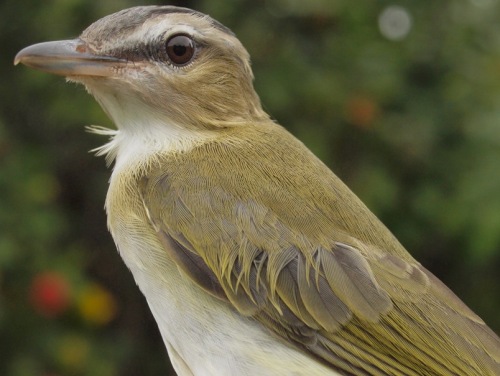
Meanwhile, Red-eyed Vireos have been at MBO since summer, but with large numbers moving through steadily throughout the season - we could well set a new fall season high next week.
(Photo by
Simon Duval)
|





